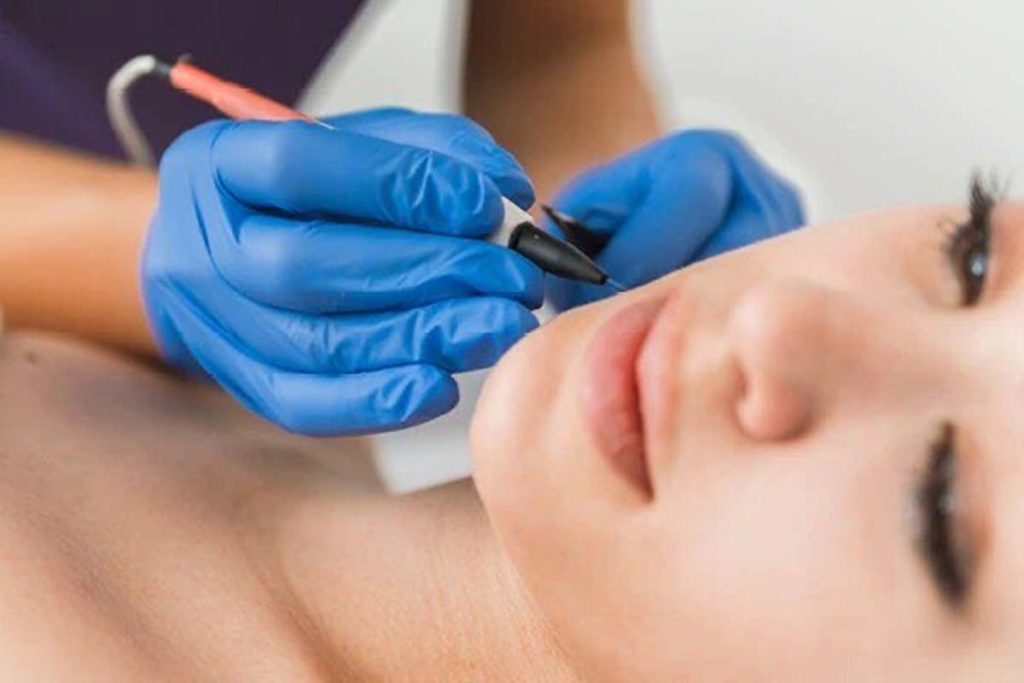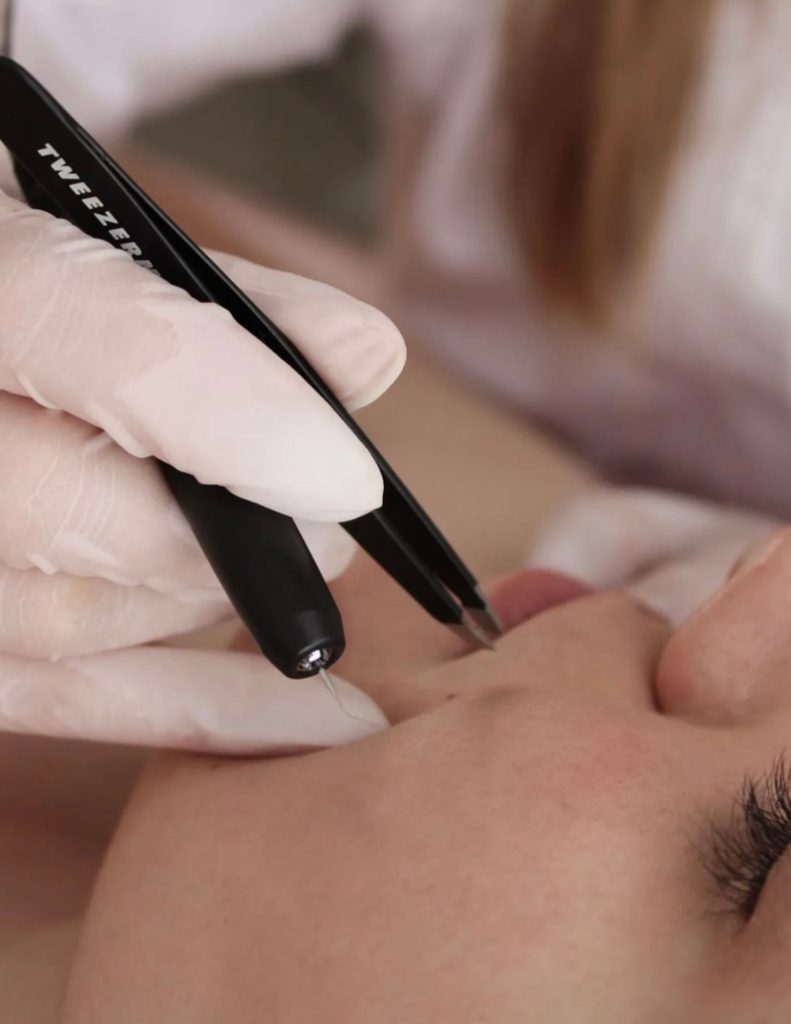Electrolysis: Questions Answered
A Permanent Unwanted Hair Removal Procedure

What is electrolysis?
Electrolysis is a form of hair removal to treat unwanted or excessive hair growth. It’s invented on 1875 by Dr. Charles Michel, making it an old form of hair removal. However, the equipment and technology has evolved significantly over the years. Today’s electrolysis procedures are quicker and more adaptable to different types of hair. The procedure involved inserting a tiny needle into the opening of each hair follicle. The probe uses an energy current to destroy living part of the follicle (the bulb and papilla) the portion containing capillaries that supply the follicle with blood. There are three types of energy modalities in electrolysis:
- Galvanic electrolysis: The current produces a chemical reaction inside the follicle to destroy the living cells.
- Thermolysis: The energy is a short-wave radio frequency that produces heat inside the follicle, which destroys the cells.
- The Blend: This modality is a combination of the two, adding heat to the chemical reaction
Unlike laser hair removal that only inhibits hair regrowth, electrolysis hair removal is permanent. In fact, it is the only permanent method of removing hair. However, hair grows in cycles and not all hair follicles are actively growing at the same time. This means it may take multiple sessions to eliminate all hair from an area. Also, Electrolysis remove light-colored hairs that Laser Hair Removal may be less effective at eliminating.
Why is electrolysis performed?
Electrolysis is performed for cosmetic reasons to get rid of unwanted or excessive hair. There are a variety of underlying reasons why hair can grow too much, including heredity, hormones, drugs, and certain medical conditions. Electrolysis can remove hair almost anywhere on the face includes the eyebrows, upper lip, chin, breasts, underarms, arms, hands, back, buttocks, abdomen, bikini line, legs and feet. Before choosing this option, ask about electrolysis benefits and risks and how they compare to other hair removal methods. Eectrolysis is FDA-approved and preferred because it provides patients with successful and long-lasting results. However, multiple treatments are required depending on hair thickness and other factors.


Who performs electrolysis?
An licensed electrologist performs this type of hair removal procedure. This allied health professional has specialized training in administering needle electrolysis. A provider may advertise permanent hair removal, but use tweezers instead of needles. This is not the same as electrolysis. Make a consultation appointment before scheduling treatment to be sure you are working with a qualified professional.
How is electrolysis performed?
What are the risks and potential complications of electrolysis?
There are very few electrolysis risks when you see a professional and experienced electrologist. Skin on the treated area may appear red and be slightly tender for a few hours afterwards. Some people are more sensitive than others to these effects. Serious skin irritation and scarring are rare.
How do I prepare for electrolysis?
For electrolysis to be effective, your electrologist must be able to see the hairs. You will need to discontinue shaving and other hair removal methods about a week beforehand. For areas like eyebrows that grow slowly, you will need to let them grow for three weeks or longer. Your electrologist may also ask you to stop retinoids and other treatments that can increase skin sensitivity.
Cleaning and gently exfoliating your skin can help the hairs release easier. If you are having facial electrolysis, do not wear makeup to your appointment. Between treatments, never tweeze or wax to remove hairs. Shave or use a depilatory lotion instead.
Questions to ask your provider
- Am I a good candidate for electrolysis?
- What options could help me achieve my desired results?
- What electrolysis modality do you recommend for me?
- How long will my procedure take?
- How many treatments do you anticipate I will need?
- How many times have you treated people with my complexion and hair texture
- Do you have before and after photos of your work that I can see?
What can I expect after electrolysis?
How long will it take to recover?
Your skin may remain slightly irritated for about 24 hours after an electrolysis treatment. During that time, avoid things that can further irritate your skin. This includes makeup, sweeting, sun exposure, and indoor tanning.


Will I feel pain?
Electrolysis is generally not painful, but it can be uncomfortable. People have varying levels of tolerance for the discomfort. For some, it won’t feel like much of anything. Others will experience a pinching, stinging, or feeling of heat during the procedure. Different body parts are also more sensitive than others.
Talk with your electrologist if you experience significant discomfort during the procedure. There are strategies for increasing your comfort, including using topical anesthetics and adjusting the treatment settings. You may also find relief by listening to music or practicing other relaxation techniques.
When should I call my provider?
How might electrolysis affect my everyday life?
Post Care Suggestions
Below are the things you shouldn’t do after your electrolysis session.
1. Don’t touch the treated area to avoid bacteria getting into your skin. It may cause you to break out. Also, don’t scratch the treated area to avoid inflammation of the skin. If it itches, resist the urge the scratch it. If your skin is irritated, you can apply Cortisone or Cortaid to reduce itching and redness. Don’t worry, though; Electrolysis has minimal side effects.
2. To prevent bacteria and infections, do apply antibiotic cream after the treatment. Make sure that your hands are clean when applying the cream. Also, ensure you follow the recommended dosage.
3. If the area swells, apply a cold compress to alleviate the symptoms. Ensure that you also stay out of the sun to prevent pigmentation. Keep in mind that the treated area may be sensitive to hyperpigmentation, but you can avoid it by not exposing yourself to direct sunlight.
4. Because your pores are open, they can become infected so ensure that you don’t apply makeup 24-48 hours after your treatment. Sponges and brushes may be full of bacteria that could lead to a breakout. Also, try not to shave 24-48 hours after treatment and don’t use astringents.
5. If you like to work out, do it 24-48 hours after treatment. Sweating may cause bacteria to get into the hair follicles, causing an infection.
6. Avoid saunas, hot tubs, and pools within 48 hours of treatment so your skin is not infected.

YAG Laser Hair Removal in Dark Skin
YAG Laser Hair Removal in Dark Skin When it comes to laser hair removal in ethnic skin, there’s a very narrow spectrum of treatment options and it has always been challenging due to the higher competing epidermal melanocyte. The Aesthetic industry has been constantly trying to develop an ideal platform

Face HydraFacial
Face HydraFacial No matter your age, your facial skin needs a helping hand in regulatingcellular renewal. We are pleased to offer a comprehensive menu of skin boosting treatments as well as personal attention through which your uniquecosmetic needs can be addressed. HydraFacial™ treatment is a process thatenables our patients to

